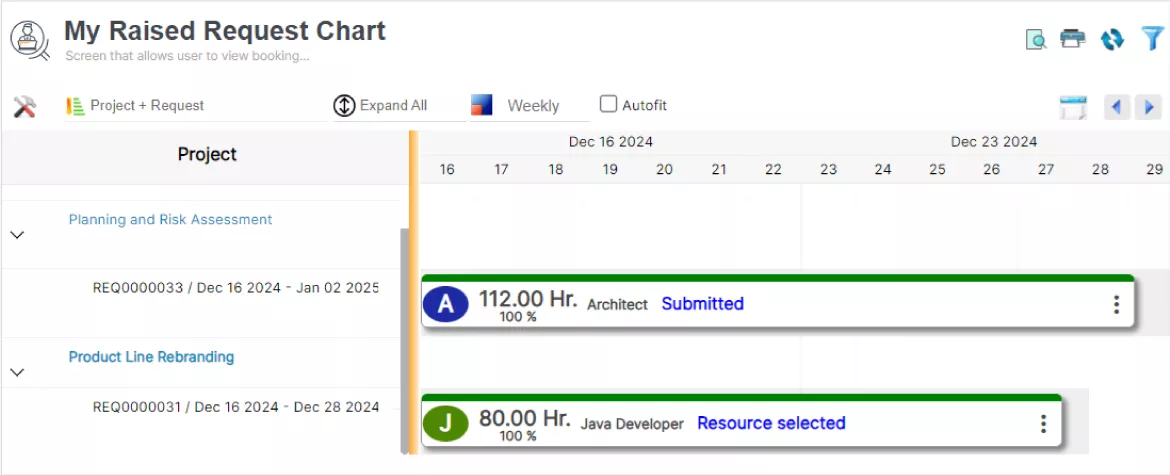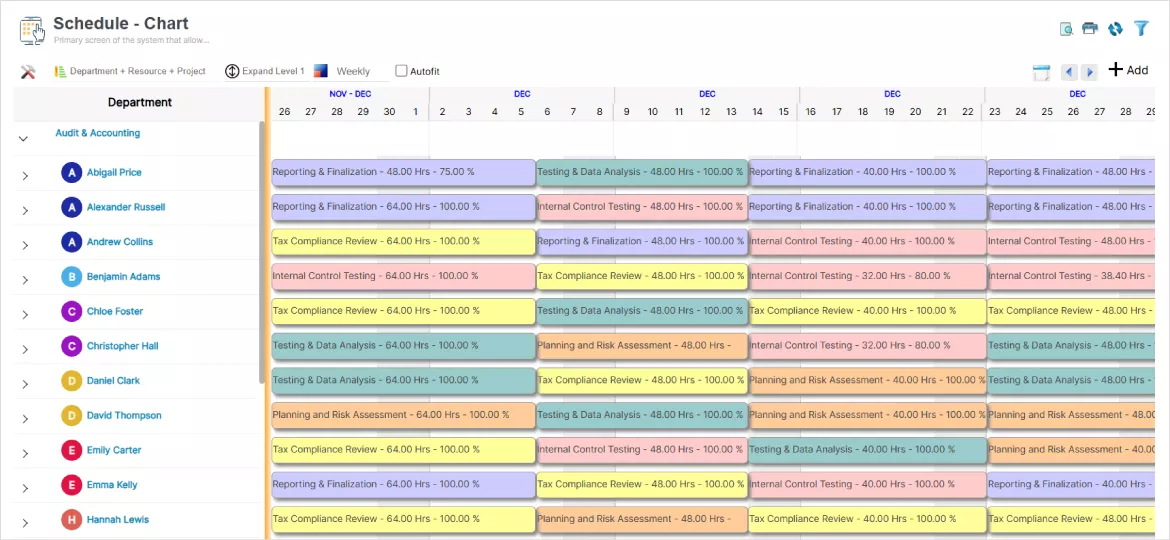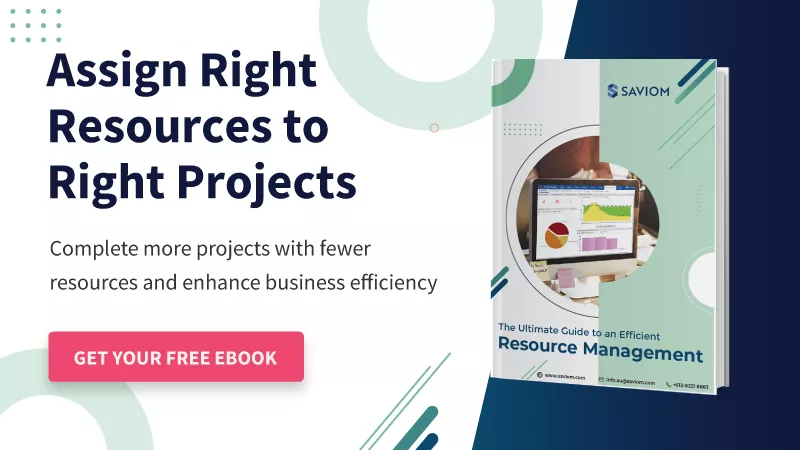According to a McKinsey survey, “83% of business leaders consider proper resource allocation as a critical management lever for growth.”
Resources, including human capital, financial assets, equipment, and others, are critical assets for any organization, and their allocation can make or break a project’s success. As a result, it is important to carefully plan and distribute these resources across various projects and business activities, ensuring that the right ones are assigned to the right tasks at the right time and cost.
Effective resource allocation is also about striking the right balance between competing priorities, optimizing resource utilization, and continuously monitoring and adjusting schedules as the project progresses. This ensures timely project delivery and improves business profitability.
In this article, we will cover the key concepts of resource allocation and how to create an effective one for your organization.
Before that, let’s start with the basics.
What is Resource Allocation?
Resource Allocation Definition
Resource allocation is the process of identifying and assigning available resources, such as workforce, finance, equipment, tools, etc., to the right projects at the right time and cost. The primary objective of resource allocation is to maximize the efficiency of the organization’s limited human and non-human assets, minimize capacity wastage, and maintain the resource health index.
Resource Allocation Example
An IT firm has a new web development project in the pipeline. So, the project manager initiates the planning process by creating a detailed Work Breakdown Structure (WBS) that summarizes all the tasks and sub-tasks involved in the entire project lifecycle. This is followed by a Resource Breakdown Structure (RBS) that entails all the resources required to execute the project efficiently.
The project manager establishes that for the project to be completed on time, they will require five backend developers proficient in Java and CSS, 2 QA testers, 2 UI/UX designers skilled in Adobe Photoshop, and 2 DevOps engineers with AWS expertise. Upon determining the requirements, the project manager submits the resource requests for all these roles to the resource manager.
Subsequently, the resource manager commences the allocation process. They look into the internal resource database to identify suitable employees with the right competencies for each role. At the same time, they also look into the availability of these resources for the specified time frame. However, the resource manager discovers that only three developers and 1 DevOps Engineer are available to take up the project, resulting in a talent shortage.
To address this, the resource manager implements an out-rotation & backfill strategy and hires contingent workers for the missing skills. By adopting a proactive approach to acquire the necessary skills, the resource manager is able to ensure that the resource requirements are met promptly and that the project starts on time.
Now that we have learned about the definition and an example for allocation in project management, let’s understand the key factors affecting the resource allocation process.
Factors That Influence the Resource Allocation Process
Certain aspects must be considered while assigning the right resources to suitable work and tasks. These elements can vary based on the project and its specifications. Listed below are some of the critical ones:
Project Goals and Objectives
The overall project goals and objectives play a significant role in determining how resources should be allocated. It enables organizations to identify the types, quality, and quantities of resources (human and non-human) required to accomplish different projects. Therefore, it helps ensure that the most critical tasks receive adequate resources and keeps projects on track.
Changes in Project Scope
Another critical factor influencing resource allocation is project scope changes. These modifications invariably alter resource demand and affect staff availability. For instance, if the scope expands and requires new skill sets, more resources must be added to the project. Therefore, project managers must carefully adjust resource allocations to meet evolving project demand.
Project and Resource Dependencies
Resource allocation decisions should also consider interdependencies between different tasks, activities, and resources within a project. Changes in resource allocation for one task can have ripple effects on other related tasks. Evaluating these interdependencies helps in optimizing resource allocation to maintain project flow and minimize bottlenecks.
Read More: What Project Interdependencies Span Your Portfolio?
Task or Project Prioritization
Categorizing and prioritizing projects enables firms to effectively utilize their limited talent pool across multiple initiatives. It helps them identify and allocate resources to high-value projects first, followed by medium and low-priority assignments. Furthermore, managers must determine the most critical tasks within the projects and accordingly assign key resources, ensuring timely project initiation and delivery.
Resource Availability and Skills
The availability of resources is a crucial factor that directly impacts allocation decisions. The manager must assess professional attributes such as skill sets, competencies, qualifications, expertise level, etc., of available resources before allocating them to project tasks. This ensures that resource skills match project demand, which facilitates successful task completion and better project performance.
Read More: What is Resource Availability in Project Management, and Why Does It Matter?
Project Deadlines
Organizations must strictly adhere to project timelines to maintain profit margins and client satisfaction. Efficient resource allocation can help firms ensure that the right people are available at the right time. This enables them to achieve project milestones, minimize the risk of schedule delays, and ensure successful delivery.
Project Cost Considerations
Another key factor is cost considerations. Balancing the resource cost rate with the available budget is crucial to ensure the financial feasibility of the project. For instance, allocating too many resources to a single task can lead to overspending, while under-allocation may result in delays or rework. Thus, a cost-effective resource allocation strategy balances quality, efficiency, and budget compliance to achieve project goals.
Read More: 5 Steps to Develop a Reasonable Project Budget that Gets Approved
Risk Assessment
Assessing potential project risks is a critical factor that directly influences the resource allocation process. Therefore, identifying potential risks, such as resource unavailability, unplanned absenteeism, or turnover, allows project managers to develop contingency plans and allocate buffer resources accordingly. This proactive approach enables managers to adjust resource allocation proactively and mitigate bottlenecks.
Now that we are clear about the various factors, let’s see how resource allocation helps improve project management.
What Are the Benefits of Resource Allocation in Project Management?
According to PMI, “50% of projects fail to deliver on time, and 23% cite poor resource allocation as the primary cause.”
Thus, a systematic resource allocation process can help organizations ensure that resources are available when required and drive every project to success. Let’s look at some benefits of resource allocation in project management.
Reduces Project Resource Cost
A proper resource allocation process enables managers to deploy cost-effective global resources across matrix boundaries and reduce project costs significantly. Moreover, it helps them build an optimal project mix of junior/senior, local/global, or permanent/contingent workforce. Thus, resource allocation boosts profitability by uniformly distributing skilled resources across all projects.
Read More: 5 Ways to Reduce Project Management Costs
Assigns Best-fit Resources to Projects
Efficient resource allocation allows firms to schedule the best-fit resources instead of the first-visible ones. Resource managers can gain a comprehensive overview of the workforce and their professional attributes to promptly identify employees whose skill sets match the project demand. When the right people are working on the right tasks, it improves project performance and delivery.
Optimizes Utilization of Every Project Member
A well-defined resource allocation process enables managers to monitor and optimize current and future staff schedules. It helps them recognize and mitigate instances of over or underutilization of resources with corrective actions. Moreover, they can identify and mobilize resources working on non-billable activities to revenue-generating tasks, thereby boosting the productive utilization of the project team.
Read More: What is Resource Utilization? A Complete Guide to Improve Business Efficiency
Helps Combat Resource Constraints Effectively
Effective resource allocation allows organizations to accomplish more projects with limited resources. It enables them to schedule multi-skilled resources to perform multiple tasks within a project instead of assigning one specific person to each task, increasing efficiency. Moreover, they can adjust allocations or use out-rotation and backfill strategies to overcome workforce constraints like skill shortages, burnout, or disengagement.
Improves Employee Engagement and Productivity
Competent resource allocation prevents the assignment of under or over-skilled employees to mismatched tasks. When resources work on tasks that match their expertise, skill sets, and interests, it increases their engagement and productivity. As a result, it improves the quality of work and ensures timely completion of tasks.
Read More: 11 Effective Strategies to Enhance Employee Engagement
Ensures Timely Project Initiation & Delivery
A well-planned resource allocation process ensures that suitable resources with the right skill sets are available before the project’s onset. It helps prevent last-minute firefighting and costly delays. Moreover, proper planning ensures that resources have an equitable workload, which helps maximize productive utilization. These factors facilitate timely project initiation and seamless delivery.
Let’s look at some of the challenges managers face when allocating resources to projects.
What are the Challenges of Resource Allocation in Project Management?
Effective resource allocation is often easier said than done. Without the right tools or techniques, identifying and allocating the right resources can be daunting. Let’s have a look at some of the resource allocation challenges that organizations face:
Reliance on Legacy Tools or Spreadsheets
Many organizations still use homegrown solutions like spreadsheets for the project resource allocation process. These tools fail to provide real-time visibility into project and resource schedules, leading to scheduling conflicts such as double bookings, resource unavailability, etc. Additionally, the absence of real-time updates leaves resources uninformed about changes in allocation, resulting in chaos and confusion about their work priorities.
Read More: How Outdated Resource Management Tools are Hurting Businesses?
Frequent Changes in Project Scope
Usually, changes in project scope leads to fluctuations in resource requirements. So, project managers have to make frequent modifications in resource allocations to cope with the changing needs. However, this proves to be an obstacle for them in the absence of real-time visibility into resource schedules. Ultimately, it results in incompetent allocation, expensive last-minute hiring, schedule/budget overruns, and project delays.
Lack of Resources Visibility Within a Matrix Organization
Most matrix organizations lack a centralized resource scheduling system that provides comprehensive visibility of the workforce and their allocations. Consequently, it becomes difficult for them to comprehend the overall capacity and availability of resources. This lack of insight affects resource managers’ ability to allocate the best-suited and cost-effective personnel to projects. Thus, it often leads to bottlenecks such as cost escalations, resource shortages, or scheduling conflicts.
Read More: What is a Matrix Organization? How to Overcome Resourcing Challenges in These Firms?
Misalignment Between Sales and Delivery Teams
While focusing on achieving sales targets, sometimes the sales team doesn’t involve the delivery team before signing the deal. As a result, the delivery team ends up scrambling for competent resources at the eleventh hour to meet the project deadline. Besides, due to a lack of visibility into sales pipeline, delivery teams may not be aware of upcoming projects, making it challenging to plan and allocate resources proactively.
Skill Mismatches and Resource Shortages
The inability to forecast pipeline project requirements prohibits organizations from identifying skill shortages in advance. It leads to a misalignment between resource capacity and project demand, resulting in skill shortages. To tackle this deficit, organizations resort to last-minute hiring of resources whose skills may not align with the project demands, causing skill mismatch.
Read More: What is Resource Capacity Planning? An Ultimate Guide for Every Project Manager
Employee Overallocation and Burnout
Due to a lack of real-time information, managers cannot assess the current and future schedules of resources before assigning them to tasks, resulting in overallocation. Over time, this excessive workload can leave resources feeling burned out. Ultimately, it can lead to unplanned absences, reduced productivity, and increased attrition.
Location and Time Zone Differences
Due to globalization, many organizations have implemented an onsite/offshore/nearshore strategy to control costs and maximize efficiency. However, in the absence of real-time visibility, it becomes difficult for managers to effectively schedule and manage a geographically dispersed team covering different time zones. This can hamper knowledge sharing and cause project delays.
Now that we are aware of the challenges, let’s dive further to understand how to allocate resources effectively.
How to Master Resource Allocation in Projects?
To ensure smooth project execution, a well-structured resource allocation framework is crucial. Here are the best ways to effectively distribute the workforce across different projects.
Establish Project Priorities and Scope
Efficient resource allocation starts with prioritizing projects based on strategic significance and their impact on revenue. For this, managers must conduct a comprehensive assessment to identify critical projects and rank them accordingly. This involves evaluating factors like project deadlines, client needs, and organizational objectives.
Once priorities are established, project managers can determine the scope of every project. It involves conducting a thorough evaluation of the objectives, timelines, and deliverables of the project. This analysis helps managers to create a WBS that clearly deconstructs the scope of work into manageable tasks and sub-tasks.
Read More: What is a Project Scope Document, and How to Create an Effective One?
Assess Resource Requirements
Once project scope is determined and WBS (Work Break Down Structure) is created, the next step is to assess resource requirements. This involves identifying the necessary skills, expertise, qualifications, and technology needed to complete each task.
Furthermore, project managers must consider factors like task complexity, interdependencies, and deadlines to determine how long resources will be engaged and when they will be needed. This way, they can accurately estimate resource requirements, which is vital to ensure that the project doesn’t face any capacity shortages or excess.
Raise Resource Requests
Once the project managers have assessed the resource demand, they will formally send a request to the resource manager. They can clearly specify the required skill sets, qualifications, experience, cost, and project timelines in the request. Accordingly, the resource manager will check the internal and external channels to analyze whether they have the necessary skills in-house.
If the required resources are readily available, then RM will schedule them to the appropriate vacancies. Otherwise, they will implement corrective measures such as out-rotation and backfilling, training, or staggered hiring to fulfil the request.

SAVIOM’s automated resource requisition workflow helps managers streamline the allocation process and maintains an immutable audit trail
Read More: 6 Easy Steps to Request Resources Efficiently
Empower Employees to Work on Projects of Interest
“According to Gallup, businesses with highly engaged employees realize an 81% difference in absenteeism and a 14% difference in productivity.”
Managers must consider employees’ interests instead of allocating them to projects only based on their skills and availability. For this, resource managers can create open positions and publish them, which become visible to all relevant personnel across the enterprise. Accordingly, interested resources can apply for the position.
After reviewing the applications, managers can then select the best-fit resources. When resources work on the project of their interest, it improves their productivity and increases their engagement levels, reducing unplanned attrition and enhancing project quality. Therefore, this method is a win-win for both resources and the managers responsible for their allocation.
Diversify Employee Skill Sets and Responsibilities
The rise of new technologies and evolving customer expectations has heightened the demand for highly skilled resources. However, acquiring these talents can pose challenges and incur significant costs for organizations. Hence, companies must proactively invest in enhancing the skills of their internal resources, which can also reduce project resource costs.
To achieve this, organizations should develop tailored training modules, offer peer-to-peer coaching, provide on-the-job training, and implement mentoring programs to upgrade the competencies of their workforce and prepare them for future projects. Moreover, this approach enables employees to refine their core skill sets and develop new ones.
Read More: Importance of Skill Development in Making Your Workforce Future-Ready
Use a Robust Resource Allocation Software
Organizations can leverage a modern resource allocation tool to streamline and document the whole process. It can help them consolidate various resource attributes, like cost, experience, competencies, etc., on a centralized platform, allowing managers to allocate best-fit professionals to every opportunity.
Moreover, advanced functionalities can help them automate the resource-requesting process and ensure project demand is swiftly addressed. Besides, the real-time tracking capabilities of the software enable firms to implement dynamic resource allocation changes and maintain project health.
Below are some of the effective methods that can be implemented to fine-tune your resource allocation strategy.
Best Practices for Resource Planning and Allocation
Some of the best practices that can be following to improve the resource allocation process are as follows:
- Get visibility of your pipeline projects in advance and plan allocation with ghost resources that can be replaced by existing resources later.
- Build a strategy for contingent resources and freelancers in addition to full-time resources. Establish a few vendor organizations that can provide resources quickly for short-term assignments.
- Encourage project managers to accept a certain number of resources matching 60-70% of actual requirements. The remaining skills can be acquired on the job.
- Plan for runtime resource allocation for some of the high-priority projects.
- Track your resource scheduling in project management details using advanced reports and dashboards. Then, plan for the resources getting rolled off from the project on specific dates.
- Have an overall risk and mitigation strategy for individual skill sets with particular emphasis on niche skills.
- Balance the resource allocation activities across the organization. Do not give priority to certain projects at the cost of others.
- Avoid allocating contingency resources for long-term or strategic projects. These positions need to be filled with regular full-time employees.
- Firms shouldn’t hire regular employees if you have short-term requirements and do not have visibility for future work. Instead, managers should opt for contingent workforce.
- Reduce the hiring/firing cycle for the resources using effective resource capacity planning.
- Do not assign critical or expensive resources to non-billable activities. This will be a waste of their skill set. Instead, junior resources or trainees can pick up non-billable tasks.
- All the high performers should not be allocated to a single project. Each project must have a combination of senior, junior, and contingency staff. It will help to create a proper band mix and increase profitability.
Let’s delve into how ideal resource management can benefit resource allocation.
How Can Resource Management Software Help Streamline Resource Allocation?
An enterprise-grade resource management software provides advanced features and functionalities that help organizations allocate resources and achieve sustainability and profitability effectively. Here’s how:
- The tool’s 360-degree visibility enables managers to allocate resources efficiently based on their skills, qualifications, availability, experience, etc. Additionally, it helps assign cost-effective global resources to projects to maintain the quality of deliverables and profitability.

SAVIOM’s multi-dimensional scheduler enables firms to match the right resources to appropriate projects based on skills, department, cost, location, etc.
- Furthermore, the forecasting and capacity planning function enables managers to forecast pipeline project demand. The capacity vs. demand reports help identify and bridge shortage/ excess of resources. This will ensure a 100% fill rate for projects to happen on time.
- The real-time BI reports and dashboards like utilization heatmaps and forecast vs. actual time/cost reports enable managers to prevent overallocation and underutilization, ensuring uniform workload distribution. Managers can also effectively mobilize resources from non-billable to billable or strategic work to ensure they are optimally utilized.
- Moreover, the system’s open seat feature allows managers to create and publish positions across the firm. Accordingly, interested candidates can apply for the work, and managers can select the appropriate ones, saving time to identify the right resource and enable effective allocation.
- Lastly, the tool’s what-if-analysis feature helps managers create various resource plans, compare their outcomes, and implement the most viable one on the actual schedule, facilitating successful allocation.
Thus, modern resource management software with advanced capabilities can help in effective resource allocation in an organization.
Read More: SAVIOM ERM Helps FTI Consulting Schedule More Than 200 Employees Efficiently
Conclusion
Effective resource allocation is paramount for business success. It ensures the appropriate distribution of organizational resources, both human and non-human, to suitable projects. To achieve this, firms can implement the above-mentioned strategies coupled with advanced resource management software and harness the full potential of their workforce, increasing project success and improving profitability.
The Glossary
Read More: Glossary of Resource Workforce Planning, Scheduling and Management












Leave a Reply